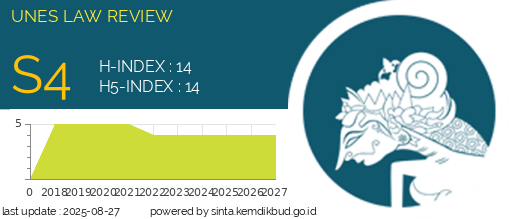DINAMIKA IMPLEMENTASI PENDEKATAN RESTORATIVE JUSTICE DALAM PENYELESAIAN TINDAK PIDANA
DOI:
https://doi.org/10.31933/unesrev.v5i4.562Keywords:
Restorative justice, Criminal offense resolution, Substantial justice, Criminal justice system, Victims and offendersAbstract
Restorative justice has emerged as an alternative approach to the traditional criminal justice system, focusing on the restoration of relationships and addressing the needs of victims, offenders, and communities. This paper explores the concept of restorative justice and its role in achieving substantial justice in the resolution of criminal offenses. By emphasizing dialogue, accountability, and repair, restorative justice seeks to transform the traditional punitive model into a more inclusive and participatory process. The paper examines the key principles and practices of restorative justice, highlighting its potential benefits for both victims and offenders. It explores how restorative justice processes provide opportunities for victims to express their feelings, receive apologies, and actively participate in the decision-making process. For offenders, restorative justice offers a chance to take responsibility for their actions, make amends, and reintegrate into the community. Furthermore, the paper discusses the challenges and limitations of implementing restorative justice within the existing criminal justice system. It acknowledges the need for comprehensive legislative frameworks, trained facilitators, and community support to ensure the successful integration of restorative justice practices. The findings suggest that restorative justice holds promise in fostering healing, rehabilitation, and social reintegration. By prioritizing the needs and voices of victims and offenders, restorative justice promotes a more balanced and humanized approach to justice. Its emphasis on repairing harm and building stronger communities contributes to the overall effectiveness and fairness of the criminal justice system.
Downloads
References
Flora, H. S. (2019). PENDEKATAN RESTORATIVE JUSTICE DALAM PENYELESAIAN PERKARA PIDANA DALAM SISTEM PERADILAN PIDANA DI INDONESIA. Law Pro Justitia, 2(2).
Helmi, M. (2015). Perlindungan Hukum Terhadap Korban Pembunuhan Sebagai Pembaharuan Hukum Pidana Di Indonesia. Mazahib, 14(1).
Herlina, A. (2004). Perlindungan terhadap Anak yang Berhadapan dengan Hukum. Manual Pelatihan Untuk Polisi, UNICEF-POLRI.
Prayitno, K. (2012). restorative justice untuk peradilan di Indonesia (perspektif yuridis filosofis dalam penegakan hukum In concreto). Jurnal Dinamika Hukum, 12(3), 407–420.
Supusesa, R. (2012). Eksistensi Hukum Delik Adat Dalam Perspektif Pembaharuan Hukum Pidana Di Maluku Tengah. Mimbar Hukum-Fakultas Hukum Universitas Gadjah Mada, 24(1), 41–54.
Surbakti, N. (2015). Peradilan restoratif dalam bingkai empiri: teori dan kebijakan. Genta Publishing.
Sutrisni, N. K. (2015). Pengaturan Advokasi terhadap Hak-hak Penyandang Disabilitas terhadap Diskriminasi di Bidang Penegakan Hukum. Jurnal Magister Hukum Udayana, 4(1), 44182.
UI, T. D. K. F. (2011). Viktimologi Reparasi dan Kompensasi Korban Dalam Restorative Justice System. Jakarta: Lembaga Perlindungan Saksi Dan Korban (LPSK).
Umbreit, M., & Armour, M. P. (2010). Restorative justice dialogue: An essential guide for research and practice. Springer publishing company.
Zulfa, E. A. (2011). Pergeseran paradigma pemidanaan. Lubuk Agung.
Downloads
Published
How to Cite
Issue
Section
License
Hak cipta :
Penulis yang mempublikasikan manuskripnya di jurnal ini menyetujui ketentuan berikut:
- Hak cipta pada setiap artikel adalah milik penulis.
- Penulis mengakui bahwa UNES Law Review berhak menjadi yang pertama menerbitkan dengan lisensi Creative Commons Attribution 4.0 International (Attribution 4.0 International CC BY 4.0) .
- Penulis dapat mengirimkan artikel secara terpisah, mengatur distribusi non-eksklusif manuskrip yang telah diterbitkan dalam jurnal ini ke versi lain (misalnya, dikirim ke repositori institusi penulis, publikasi ke dalam buku, dll.), dengan mengakui bahwa manuskrip telah diterbitkan pertama kali di Jurnal UNES Law Review.



















